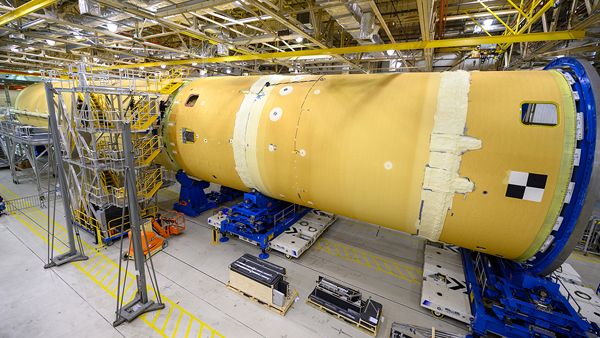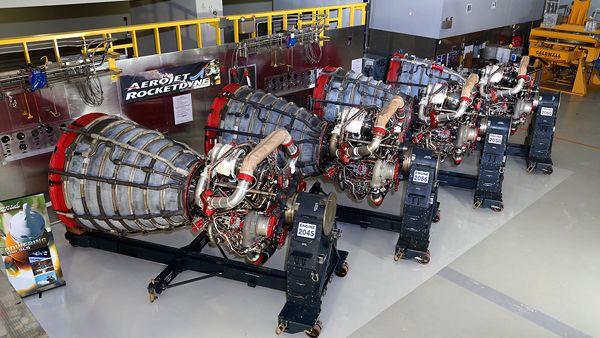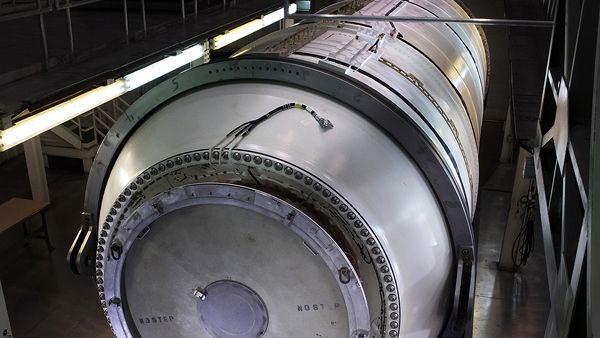
NASA / Eric Bordelon
NASA Reaches New Milestone on Complex, Large Rocket (News Release)
NASA achieved a significant milestone in manufacturing the first large, complex core stage that will help power the Space Launch System (SLS) rocket on upcoming missions to the Moon. NASA and lead contractor Boeing have assembled four-fifths of the massive core stage needed to launch SLS and the Orion spacecraft on their first mission to the Moon: Artemis 1.
The Artemis program will send the first woman and the next man to the Moon by 2024 and develop a sustainable human presence on the Moon by 2028. The program takes its name from the twin sister of Apollo and goddess of the Moon in Greek mythology.
“This milestone brings the Space Launch System closer to launching the first Artemis mission,” said John Honeycutt, SLS program manager. “The SLS rocket team is laser focused on building the rocket not only for the first flight but also rockets for the second and third Artemis missions that will send astronauts to the Moon.”
At approximately 190 feet, about the size of 12 cars parked end-to-end, the stage in its current configuration is the largest rocket stage the agency has built since the Saturn V stages that first sent humans to the Moon nearly 50 years ago. The completed core stage, which includes two propellant tanks as well as four RS-25 engines, will tower at 212 feet. It, along with the twin five-segment solid rocket boosters, will produce the majority of the power to send the SLS and Orion to space.
“Building and assembling this massive integrated propulsion and avionics stage for the world’s most powerful rocket, the only launch vehicle that can return astronauts to the Moon, is an engineering feat,” said Julie Bassler, SLS stages manager. “To manufacture the Space Launch System, we are working with more than 1,000 companies across the country. It’s truly America’s rocket.”
This significant program milestone comes after crews completed the second of three major activities to join the liquid hydrogen fuel tank to the upper part of the core stage. The upper part is made up of three previously connected large structures: the forward skirt that houses the rocket’s flight computers, the liquid oxygen propellant tank, and the intertank that holds more avionics and attaches to the rocket’s powerful boosters. Technicians horizontally connected the liquid hydrogen tank to the intertank using 360 bolts. NASA and Boeing, the SLS prime contractor, will now complete outfitting the engine section before integrating it, along with the four RS-25 engines, to the rest of the stage, completing the immense core stage in its entirety.
In response to President Trump’s charge to return Americans to the Moon by 2024, engineers and technicians revised the core stage assembly plan to mate the individual structures horizontally rather than vertically. These milestones — combined with new production tools and the team’s responsiveness — keep core stage production on track for completion by the end of the year.
“NASA is constantly looking for ways to get work done more efficiently so that we can get astronauts landing on the Moon by 2024,” said Ben Birkenstock, the SLS stages vehicle assembly lead. “The NASA and Boeing team is learning while building this first core stage. The decision to integrate the core stage structures horizontally demonstrates our efforts to continuously improve our operations.”
The SLS team continues to make progress on other elements for the rocket’s first three missions. In April, the last of 16 RS-25 engines from the space shuttle program passed inspection, capping a 51-month acceptance test series at NASA’s Stennis Space Center near Bay St. Louis, Mississippi and clearing all engines suitable for flight. The manufacture and checkout of all 10 motor segments for the twin boosters on the first Artemis flight were completed in January. NASA and Northrop Grumman technicians in Promontory, Utah, applied insulation to all the booster segments for Artemis 2 in the spring. The solid rocket boosters and four RS-25 engines produce a combined thrust of 8.8 million pounds during launch and flight.
Other parts of the rocket for the first flight, like the launch vehicle stage adapter and the solid rocket boosters, will soon be delivered to NASA’s Kennedy Space Center in Florida. The interim cryogenic propulsion stage that will give NASA’s Orion spacecraft the push needed to get to the Moon and the adapter that will connect that stage to the spacecraft have already been delivered to Kennedy.
NASA is working to land the first woman and next man on the Moon by 2024. SLS and Orion, along with the Gateway in orbit around the Moon, are NASA’s backbone for deep space exploration. SLS is the only rocket that can send Orion, astronauts and supplies to the Moon on a single mission.
Source: NASA.Gov
****

NASA

Northrop Grumman

No comments:
Post a Comment